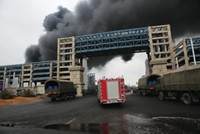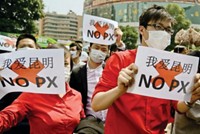Advertisement
Grab your lab coat. Let's get started
Welcome!
Welcome!
Create an account below to get 6 C&EN articles per month, receive newsletters and more - all free.
It seems this is your first time logging in online. Please enter the following information to continue.
As an ACS member you automatically get access to this site. All we need is few more details to create your reading experience.
Not you? Sign in with a different account.
Not you? Sign in with a different account.
ERROR 1
ERROR 1
ERROR 2
ERROR 2
ERROR 2
ERROR 2
ERROR 2
Password and Confirm password must match.
If you have an ACS member number, please enter it here so we can link this account to your membership. (optional)
ERROR 2
ACS values your privacy. By submitting your information, you are gaining access to C&EN and subscribing to our weekly newsletter. We use the information you provide to make your reading experience better, and we will never sell your data to third party members.
Business
The Public Wins In Dalian
Spontaneous protests lead to closure of a Chinese petrochemical facility
by Jean-François Tremblay
September 26, 2011
| A version of this story appeared in
Volume 89, Issue 39

People power is taking hold in China. The government of the city of Dalian ordered the closure of a petrochemical plant last month after large protests erupted over the risks that residents feared it poses. The facility was commissioned only two-and-a-half years ago at a cost of some $1.5 billion.

Neither the city government nor the plant’s owners have been willing to explain how a recently built chemical plant is so unsafe that it needs to be shut down. The scant information that is available points to a rushed regulatory approval of a poorly conceived facility. The tale serves as a warning to other companies in China that do not assign a high priority to industrial safety and community relations.
Residents of Dalian are, by and large, not hostile to industry. The northeastern Chinese city hosts large shipyards, has oil refineries and industrial chemical plants, and is a major oil distribution center. Its environmental activists aren’t of the militant type.
“I recognize that we need to make these chemical products to support China’s development,” says Zailin Tang, office chief of the Dalian Environmental Protection Volunteers Association, one of Dalian’s most prominent environmental groups. “But we need to do this in a safe and environmentally friendly way.” The recent public protests emerged spontaneously, Tang says, and didn’t involve his group.
Called Fujia Dahua Petrochemical, the aromatics facility is a joint venture between local real estate developer Fujia Group, which owns a 55% stake, and Dalian Petrochemical, a subsidiary of PetroChina that owns the other 45%.
Consultants at Mitsubishi Chemical Techno-Research in Tokyo reckon that the plant was built by Sinopec Engineering on the basis of process technology licensed from the French engineering company Axens. The plant has annual capacity to produce 700,000 metric tons of p-xylene, the key intermediate for terephthalic acid, which in turn is used to make polyester fiber and plastics. According to petrochemical market information services firm Platts, the Fujia facility can also produce up to 350,000 metric tons of benzene per year.
Opposition to the aromatics complex erupted in early August after large waves from Typhoon Meihua threatened to damage seaside storage tanks containing its output. The plant is located about 10 miles from Dalian’s city center, and the public feared that a spill of chemicals into the sea would contaminate the whole area. The storm did wash away a dike protecting the complex from the sea, and the army repaired it.
By the middle of the month, tens of thousands of demonstrators had assembled in front of Dalian city government offices. After several days of protests, city officials ordered the facility closed. The company’s standing during this period had been weakened by reports in Chinese blogs that the plant had started to operate without completing an environmental impact assessment.
According to Tang, p-xylene has had a negative image in China ever since protestors in the southern city of Xiamen prevented the construction of a p-xylene plant in 2007. Moreover, the Dalian government and Fujia did a poor job of explaining the public benefits of having an aromatics plant in their city, Tang says.
Indeed, Fujia’s cavalier attitude toward public relations inflamed public passions against the firm. It was widely reported in the Chinese media that reporters from China’s national television news who approached the Fujia facility during the typhoon were assaulted by Fujia employees. The company did not grant interviews during the protests. Several weeks later, Fujia used security guards to turn away a C&EN reporter seeking to meet with executives at the firm’s headquarters in Dalian.
Dalian is no stranger to unfortunate incidents involving oil and chemicals. In July 2010, a large oil slick formed in the sea near Dalian after an explosion at a pipeline. A Dalian Petrochemical refinery experienced a series of accidents over the past year, including a fire in July. Most recently, an explosion occurred at Dalian Petrochemical in late August.
Still, it’s unusual for a plant producing p-xylene to attract this much negative sentiment, says Mehdi Adib, chief executive officer of Jurong Aromatics. His company is building its own p-xylene facility in Singapore (C&EN, Sept. 19, page 18). Larger than the Fujia plant, it’s located on Jurong Island, roughly as far from the center of Singapore as the Fujia plant is from Dalian’s center.
“Almost anywhere in the world that you see a refinery, chances are that there will be an aromatics unit within. I didn’t hear about anybody getting too excited about this,” Adib says of his firm’s project.
During the Dalian protests, residents there expressed particular fears about the toxicity of p-xylene. But it’s benzene, which is usually coproduced at aromatics plants, that holds the most potential for harm, says Tiankanok Sirichayaporn, Bangkok-based senior aromatics analyst for the consulting firm Nexant. Benzene is toxic even at low concentrations. “Many refineries in the U.S. have been fined for their benzene emissions,” Sirichayaporn says.
As the population of Dalian grows, residential areas are beginning to abut industrial ones. It is likely that opposition to the Fujia facility was led by affluent residents who bought luxury apartments relatively close to Dalian’s refining district. “I heard people from one apartment complex got together one day and organized this demonstration,” a businessman who shuttles between Dalian and the U.S. tells C&EN. He requested anonymity because of his frequent dealings with Dalian officials.
Tang believes that Fujia may not have designed the facility as thoughtfully as it could have. “When you build a large industrial facility, you need to consider the possibility of natural events like typhoons and earthquakes,” he says. Tang believes the company may be forced to relocate the facility away from the center of Dalian.
Opposition to the facility is a historic milestone, Tang adds. “We are seeing the emergence of feelings of citizenship and environmental responsibility among Dalian residents,” he says. ◾




Join the conversation
Contact the reporter
Submit a Letter to the Editor for publication
Engage with us on Twitter